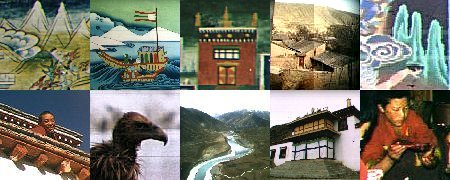Architecture


Stories:
Sichuan
Qinghai
Shaanxi
Guangxi
Photos:
People
Wildlife
Landscape
Architecture
Painting
Most Tibetan monasteries have no communal living space. Each monk has a comfortable, 2 story home for himself. Here the temple buildings are placed centrally.
The main temple viewed from a spot at the top left of the first picture.


The friars' living quarters. With these homes, the first stock is offset backwards. They sometimes lean against each other, but do not make up a single building.
On the picture to the right, one long building is divided into several two story homes.


The tibetan quarter in Yushu. Mani flags are hung in above the front doors.
The rods that stick out of the walls are wooden draining pipes allowing melt water off the roof.

A Tibetan village viewed from above. These farmers both keep cattle and grow barley. Their homes are more luxurious then those of farmers who only keep cattle. The ground floor is used for stables and storage (the collecting pit of the latrine is also placed here). On the first floor are the living quarters consisting of three or four rooms. Here, straw is stored on the roof.


As can be seen on the picture on the right, the temple wall is topped by a dark band. This band is made of compressed twigs from an aromatic bush. These twigs are also a replacement for incense.



We now turn to Chinese architecture. This is the Taoist Bei Shan monastery directly north of Xining. Along the constantly eroding loess and limestone mountain face a gallery is dug out that allows access to the niches where several saints are placed.
To the right a dragon sculpture on one of the temples' roofs. Please note the imprint on the endplates of the tiled roof.

Chorten in Tianduo. Behind each brass shield a holy sculpture is placed. The bases of the chorten are all different.
photos: Thijlbert Duvekot,
2000
mail
